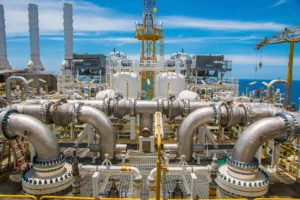Wrong direction of rotation
Although both non-reversible electric and pneumatic motors usually rotate clockwise, both types of motors also rotate in the opposite direction.
Electric motors rotate clockwise, as seen when looking at the shaft, and in the case of pneumatic motors, when looking at the air-intake end. This means that non-reversible pneumatic motors rotate counter-clockwise when looking at the shaft. As a result, it is always necessary to pay attention to the information provided in the technical literature. If you do not find out that the motor rotates in the wrong direction until the first trial run, you not only have deadline problems, but the reversible motor that can be used as a replacement will always be less powerful.
Improper connections
If you switch hoses when you connect up a pneumatic motor, it will still run, but changes in the direction of rotation will be uncontrollable, and both speed and torque will be too low. These problems can result from the following errors:
1. connecting an intake line to the outlet fitting
2. plugging up the outlet fitting;
3. using the wrong control valve to close the outlet line so that it functions as a plug.
If you find that such errors have been made, first check the connection diagram in the motor documents.
However, you can always be sure that the motor will not be damaged by such mistakes.
Start-up
If a new motor does not seem to want to start, pour a little oil into the intake opening from an oil can. This brief excess lubrication washes out the preservative oil that manufacturers put into the motor chamber to prevent corrosion and can cause the vanes to stick. The motor should then start without any problem.
Power drop after brief period of operation
If a pneumatic motor starts to deliver less power shortly after being put into operation, you can always assume that a lack of lubrication is the cause. The lubricator may have been set too low, or the oil tank may have emptied because the oil setting was too high. As was mentioned on Page 74, lubricators have to be checked regularly. It is always advisable to make a specific individual responsible for this.
Water in the motor
This can be caused by the fact that the condensate in the filter tank was not emptied. If the tank fills up with condensate too often, it is advisable to install a filter with an automatic condensate drain. This situation can, of course, also result from a defect in the compressor aftercooler, or the dryer may have stopped functioning.
The system doesn’t deliver full power
It can happen that a system will not deliver its rated performance even if the motor, air lines, and valves are properly dimensioned and the lubricator, filter (arrow), and controls are properly installed and completely functional.
A frequent cause is that the required flow of air doesn’t reach the motor. This can be ascertained by using a pressure gauge to measure the pressure drop at the entry to the system. The following causes are possible:
1. the choke point (inadequate cross-sectional area in the intake line between the compressor and the system);
2. another piece of equipment that uses compressed air consumes too much of the compressed air produced by the compressor, occasionally or permanently;
3. excessive (unknown) leaks in the circuit that cut down the available flow of air;
4. pressure is set too low.
Motor temperature: pneumatic motors stay “cool“
One of the major advantages of pneumatic motors is that the more they work, the cooler they run. First, the air flowing into the motor provides a cooling effect, and secondly, this air also absorbs heat when it expands to drive the motor.
In general, pneumatic motors can withstand temperatures ranging between -30°C and +100 °C. When pneumatic motors are used at temperatures lying under +5°C, there is the danger that they will ice up if the compressed air is not dried before it enters the motor.
Compressed-air fittings
Pneumatic fittings remain the weak link in compressed-air technology, which is a pity because they can actually pay for themselves by reducing pressure drops, which means substantial energy savings.
This problem has already been mentioned on Page 74. Wherever pneumatic motors are used, the choice of fittings, that is, the units which provide the right air throughput with the least possible pressure drop, is especially critical. Catalogues for compressed-air fittings are available, which contain everything from shut off valves to quick-release couplings and hoses. They are a big help when it comes to pneumatic equipment, tools or motor systems. What is especially useful – is that they contain complete installation sets which guarantee specific maximum pressure drops for specific circuits, which are presented with a reference operating pressure of p. = 6 bar. In addition, the maximum air throughput (maximum flow) and the concomitant pressure drop are given for each individual fitting to make it possible to design the air-supply system for a pneumatic motor without any difficulty at all. [1]
Reference:
[1] Möller Druck und Verlag, 1983, “Pneumatic Motors in Theory and Practice” Copyright by Atlas Copco Tools GmbH
Contact us directly or Click the link to find more detailed information about industrial air and electric motor technologies.


